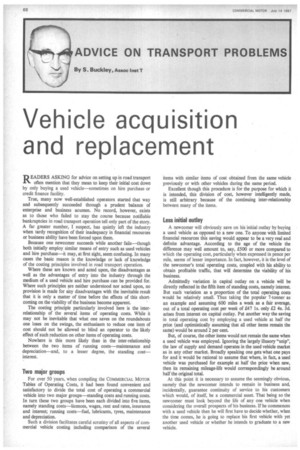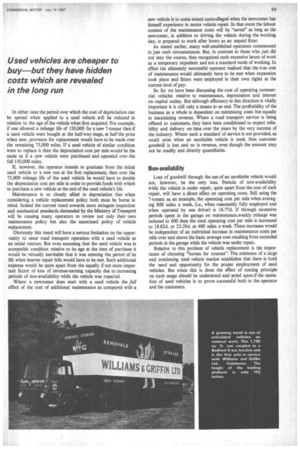Vehicle acquisition and replacement
Page 70

Page 71

If you've noticed an error in this article please click here to report it so we can fix it.
READERS ASKING for advice on setting up in road transport often mention that they mean to keep their initial cost down by only buying a used vehicle—sometimes on hire purchase or credit finance facility.
True, many now well-established operators started that way and subsequently succeeded through a prudent balance of enterprise and business acumen. No record, however, exists as to those who failed to stay the course because notifiable bankruptcies in road transport operation tell only part of the story. A far greater number, I suspect, has quietly left the industry when tardy recognition of their inadequacy in financial resources or business ability have been forced upon them.
Because one newcomer succeeds while another fails—though both initially employ similar means of entry such as used vehicles and hire purchase—it may, at first sight, seem confusing. In many cases the basic reason is the knowledge or lack of knowledge of the costing principles involved in road transport Operation. Where these are known and acted upon, the disadvantages as well as the advantages of entry into the industry through the medium of a used vehicle and hire purchase can be provided for. Where such principles are neither understood nor acted upon, no provision is made for any disadvantages with the inevitable result that it is only a matter of time before the effects of this shortcoming on the viability of the business become apparent.
The costing principle particularly involved here is the interrelationship of the several items of operating costs. While it may not be inevitable that what one saves on the roundabouts one loses on the swings, the enthusiasm to reduce one item of cost should not be allowed to blind an operator to the likely effect of such reduction on other items of operating costs.
Nowhere is this more likely than in the inter-relationship between the two items of running costs—maintenance and depreciation—and, to a lesser degree, the standing cost— interest.
Two major groups
For over 50 years, when compiling the COMMERCIAL MOTOR Tables of Operating Costs, it had been found convenient and satisfactory to divide the total cost of operating a commercial vehicle into two major groups—standing costs and running costs. In turn these two groups have been each divided into five items, namely standing costs—licences, wages, rent and rates, insurance and interest; running costs—fuel, lubricants, tyres, maintenance and depreciation.
Such a division facilitates careful scrutiny of all aspects of commercial vehicle costing including comparison of the several
items with similar items of cost obtained from the same vehicle previously or with other vehicles during the same period.
Excellent though this procedure is for the purpose for which it is intended, this division of cost, however intelligently made, is still arbitrary because of the continuing inter-relationship between many of the items.
Less initial outlay
A newcomer will obviously save on his initial outlay by buying a used vehicle as opposed to a new one. To anyone with limited financial resources this saving would appear to be a very real and definite advantage. According to the age of the vehicle the difference may well amount to, say, £500 or more compared to which the operating cost, particularly when expressed in pence per mile, seems of lesser importance. In fact, however, it is the level of the newcomer's total operating costs, coupled with his ability to obtain profitable traffic, that will determine the viability of his business.
Admittedly variation in capital outlay on a vehicle will be directly reflected in the fifth item of standing costs, namely interest. But such variation as a proportion of the total operating costs would be relatively small. Thus taking the popular 7-tonner as an example and assuming 600 miles a week as a fair average, out of a total operating cost per week of 147 is. only /2 4s. 3d. arises from interest on capital outlay. Put another way the saving in total operating cost by employing a used vehicle at half the price (and optimistically assuming that all other items remain the same) would be around 2 per cent.
But, of course, the other items would not remain the same when a used vehicle was employed. Ignoring the largely illusory "snip", the law of supply and demand operates in the used vehicle market as in any other market. Broadly speaking one gets what one pays for and it would be rational to assume that where, in fact, a used vehicle was purchased for example at half the price when new, then its remaining mileage-life would correspondingly be around half the original total.
At this point it is necessary to assume the seemingly obvious, namely that the newcomer intends to remain in business and, incidentally, guarantee continuity of service to his customers which would, of itself, be a commercial asset. That being so the newcomer must look beyond the life of any one vehicle when considering the overall prospects of his business. If he commences with a used vehicle then he will first have to decide whether, when the time comes, he is going to replace his first vehicle with yet another used vehicle or whether he intends to graduate to a new vehicle. In either case the period over which the cost of depreciation can be spread when applied to a used vehicle will be reduced in relation to the age of the vehicle when first acquired. For example, if one allowed a mileage life of 150,000 for a new 7-tonner then if a used vehicle were bought at the half-way stage, at half the price when new, provision for replacement would have to be made over the remaining 75,000 miles. If a used vehicle of similar condition were to replace it then the depreciation cost per mile would be the same as if a new vehicle were purchased and operated over the full 150,000 miles.
If, however, the operator intends to graduate from the initial used vehicle to a new one at the first replacement, then over the 75,000 mileage life of the used vehicle he would have to double the depreciation cost per mile in order to provide funds with which to purchase a new vehicle at the end of the used vehicle's life.
Maintenance is so closely allied to depreciation that when considering a vehicle replacement policy both must be borne in mind. Indeed the current trend towards more stringent inspection and mechanical standards demanded by the Ministry of Transport will be causing many operators to review not only their own maintenance policy but also the associated policy of vehicle replacement.
Obviously this trend will have a serious limitation on the opportunity to enter road transport operation with a used vehicle as an initial venture. But even assuming that the used vehicle was in acceptable condition relative to its age at the time of purchase it would be virtually inevitable that it was entering the period of its life when heavier repair bills would have to be met. Such additional eipense would be quite apart from the equally if not more important factor of loss of revenue-earning capacity due to increasing periods of non-availability while the vehicle was repaired.
Where a newcomer does start with a used vehicle the full effect of the cost of additional maintenance as compared with a new vehicle is to some extent camouflaged when the newcomer has himself experience in motor vehicle repair. In that event the labour content of the maintenance costs will be "saved" as long as the newcomer, in addition to driving the vehicle during the working day, is prepared to work after hours as an unpaid fitter.
As stated earlier, many well-established operators commenced in just such circumstances. But, in contrast to those who just did not stay the course, they recognized such excessive hours of work as a temporary expedient and not a standard mode of working. In effect the ultimately successful operator realised that the true cost of maintenance would ultimately have to be met when expansion took place and fitters were employed in their own rights at the current level of pay.
So far we have been discussing the cost of operating commercial vehicles relative to maintenance, depreciation and interest on capital outlay. But although efficiency in this direction is vitally important it is still only a means to an end. The profitability of the business as a whole is dependent on minimising costs but equally in maximising revenue. Where a road transport service is being offered to customers, they have been conditioned to expect reliability and delivery on time over the years by the very success of the industry. Where such a standard of service is not provided, as could arise when an unreliable vehicle is used, then customer goodwill is lost and so is revenue, even though the amount may not be readily and directly quantifiable.
Non-availability
Loss of goodwill through the use of an unreliable vehicle would not, however, be the only loss. Periods of non-availability while the vehicle is under repair, quite apart from the cost of such repair, will have a direct effect on operating costs. Still using the 7-tonner as an example, the operating cost per mile when averaging 800 miles a week, (i.e., when reasonably fully employed and when operated by one driver) is 16.77d. If through excessive periods spent in the garage on maintenance,weekly mileage was reduced to 600 then the total operating cost per mile is increased to 18.82d. or 23.29d. at 400 miles a week. These increases would be independent of an individual increase in maintenance costs per mile over and above the basic average cost resulting from extended periods in the garage while the vehicle was under repair.
Relative to this problem of vehicle replacement is the importance of choosing "horses for courses". The existence of a large and continuing used vehicle market establishes that there is both the need and opportunity for the proper employment of used vehicles. But when this is done the effect of costing principle on such usage should be understood and acted upon if the operation of used vehicles is to prove successful both to the operator and the customers.


























































































































